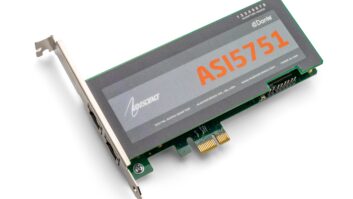The last thing you want your station’s digital audio coursing through is the on-board audio interface found on many motherboards.
Product CapsuleThumbs Up:
Superb specs and low self — noise
Plug-and-play installation
Linux support
Internal DSP on mic input
Thumbs Down:
Single combined output
Does not handle onboard MPEG or Dolby digital audio.
Price: $545
For information, contact Audio Science in Delaware at (302) 324-5333 or go to www.audioscience.com.
When the sound card is actually an integrated element of the entire PC system, you are never guaranteed decent sound or any simple means of “ungluing” the interface from operation.
You may defeat it in BIOS, but let’s face it: you should start out with a really good audio interface from the get-go.
So once you have turned off the on-board interface and begun your search for a dedicated sound card, remember that your entire station is going to hinge on the audio quality and stability of the device you choose.
Skip the musician’s card and the home Blaster bundle and go right for the AudioScience ASI5111, a PCI audio adapter intended for high performance, up to 96 kHz sample rate and extremely low noise.
A lot, a little
A superb sounding card, the ASI5111 has a feature set that is surprisingly austere. It excels at recording and playing back 8-, 16 — and 32 — bit PCM audio at numerous sample rates.
It does not handle MPEG or Dolby AC2 files, however, and it has only one physical set each of balanced analog inputs and outputs and switchable S/PDIF or AES/EBU digital ins and outs.
Should your tasks require handling these file types through multiple I/Os, such as running outputs to three pots on the console, you may want to consider the higher-priced AudioScience ASI6118 interface instead.
The ASI5111 is a compact PCI card with D-sub connectors and a 1/4-inch TRS jack on the backplane. Its signature appearance, an orange metal shield, covers critical circuitry that no doubt contributes to outstanding SNR figures.
The nine — pin D — sub connectors basically behave like boy-girl seating: the female connector carries analog audio, the male connector handles the digital stream.
The 1/4 — inch phone jack takes microphone — level input, amplifies it and routes it through a fairly capable Texas Instruments DSP chip, applying compression and limiting, followed up by five-band EQ. There is even +48V phantom power available at the mic jack.
As the jack takes a phone-style plug, an XLR-to-TRS adapter must be used.
Unlike those computer store sound cards with their noisy and inefficient Mic In jacks, the ASI5111 is one audio interface you can confidently plug a decent microphone into and expect it to sound good. The compressor has a hard breakaway (knee), and extreme amounts will squash things pretty well.
While it remains best to send mic signals through your console and feed the line-level inputs to the ASI5111, a direct microphone can take advantage of the onboard processing to shape the dynamics and keep things bright.
And unlike cheapie sound cards, the ASI5111 comes with breakout cables with D connectors at one end and balanced XLRs at the other. Connect the ASI5111 directly into your existing rig without experiencing that uneasy feeling associated with mini — plugs or phono — style S/PDIF jacks.
Spec-wise, the ASI5111 boasts published figures of — 100 dB SNR and an ear — pleasing 0.0025 percent THD+Noise, with its 24-bit A/D and D/A converters.
I am unable to verify these figures in my home studio. But my own fairly nonscientific test, to be described in a moment, certainly revealed superior performance.
In use
The ASI5111 was installed in a Compaq PIII-500 PC running Windows 98SE, still a viable operating system for audio playback (AudioScience supports Win 98 through XP and Linux, too).
A CD-ROM is bundled with the interface; but to play it safe, I downloaded the latest Windows drivers at the AudioScience Web site, along with ASIMixer, the software mixer that sets all parameters and DSP settings for the card.
ASIMixer lets you alter input and output response from -10 to +20 dBu in 1 dBu steps. The mic can be set for 20, 40 or 60 dB gain. You may also dial in your compression and EQ settings here.
Once in and running, I launched Cool Edit 2.0 to first observe how the interface behaved without any actual audio applied to it.
My own evaluation of any audio interface begins with a look at its own quiescent noise.
Cheap cards generate lots of it. The cheaper the card, the higher the noise – detected as a high flickering VU meter when recording and as background hiss during playback.
No noise = good news
The ASI5111 stayed quieter than any other audio interface I have tried. The waveform line stayed quite flat at zero, while the Cool Edit VU bar danced slightly at — 87 dB — much quieter than I would have expected.
Zooming in on the waveform, my first sign of any noise occurred between -0.006 percent and +0.002 percent of Adobe Audition’s (formerly Cool Edit) entire dynamic range (see Fig. 1). Very respectable.
Again, this is as unscientific an examination as one would want, but it sure tells a compelling story.
Is this degree of noise immunity that important for broadcast production? Think about it. Take several tracks, all containing a level of hiss, and make a mixdown. Those little slices of noise add up quickly and affect the end product.
Before recording any analog audio via the XLRs, the interface had to be zeroed first in the AudioScience mixer window to avoid clipping. The capture was clean, with wide highs and no distortion at 44.1 kHz sample rate – just the way a high end card should behave.
The audio specs on the ASI5111 are impeccable and the balanced XLR cables mean the interface can jack directly into your console with no intermediate IHF-to-Pro matching device.
Again, the only concern you should have is that the ASI5111 is a one-in, one-out card. This is not an interface for simultaneous multitrack recording (say, like the 001 interface for Pro Tools). The intent is to input one element at a time, then mix down all elements in software to a single output.
You want multiple outputs? Step up to the AudioScience ASI6118 card, with its eight stereo outputs.
Also, it must be repeated that, while the ASI5111 handles PCM WAV files superbly, on-board MPEG and Dolby encoding/decoding is not a feature of this card.
By the way, do not go looking for an internal audio connection for your CD-ROM drive. Unlike Blaster-compatible sound cards, the ASI5111 is dedicated solely to moving audio in and out of the backplane ports.
The individual microphone input on the backplane actually is useful. I can bypass the console and plug directly into the PC with the mic, and still take advantage of low noise and processing similar to what I might dial up on a dbx 286 or Symetrix 528 mic processor.
Summary
The ASI5111 is a natural in PC-based radio broadcast and production systems, its primary design consideration. Numerous manufacturers, such as BSI, have adopted AudioScience interfaces for use with digital on-air storage and playback software.
For production, the ASI5111 becomes an outstanding performer when built into a PC outfitted as a multitrack workstation, as long as you are okay with loading in one audio element at a time.
In all, the ASI5111 is a high-caliber performer. One of its beefier brothers may turn out to be a better choice if you wish to go the multiple I/O route.









